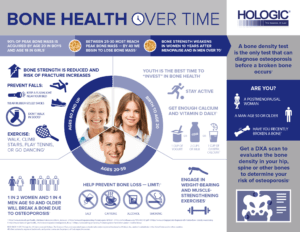Take Charge of Your Bone Health During National Osteoporosis Month
What You Need to Know
We all know there are certain health screenings that consistently remain top-of-mind – mammograms for breast health, dermatology appointments to scan for melanoma, colonoscopies to detect and prevent colon cancer, but screening for osteoporosis too frequently flies under the radar. Despite the fact that osteoporosis causes 2 million bone fractures each year and leads to more than 800,000 emergency room visits and more than 2.6 million doctor’s appointments annually, people around the country don’t prioritize their bone health the way that they should. Osteoporosis, known as the “silent killer” because it often goes undetected before it’s too late, affects 4 out of 5 women, and many men. But what the majority of people don’t know is that it is preventable, and National Osteoporosis Month is the perfect time of year to educate yourself on the importance of prioritizing your bone health, especially as you age.
And..
While ninety percent of peak bone mass is acquired by age 20 and mass begins to be lost in our forties, there are plenty of ways to reduce your fracture risk and maintain bone strength once you hit fifty, and beyond. Once my patients make the decision to take control of their bone health, I often recommend that the first step they take is to get a baseline DXA scan to measure their bone density.
Additionally, it’s important to take measures to prevent falls; precautions like wearing rubber-soled shoes for traction, or keeping a flashlight by your bedside at night for increased visibility are simple actions that can make a dramatic impact on fracture risk reduction. It’s also important to stay active to help maintain your bone mass – exercises such as walking, climbing stairs, playing tennis and exercise disguised as fun (like dancing) are great ways to help keep your bones strong.Finally, avoid smoking and limit alcohol intake to achieve your best bone health.
What You Need to Do
The National Osteoporosis Foundation recommends that all women over 65 or of postmenopausal age with risk factors, as well as men over 70, talk with their doctors about undergoing a DXA scan to test for and diagnosis osteoporosis. The sad reality is that only 23 percent of eligible patients actually undergo a scan, a startling statistic, and one we can work to overcome. I urge you to use National Osteoporosis Month as a reminder to talk with your doctor and schedule a painless, 15-minute, DXA scan– statistics show that women who have bone density scans have 35 percent fewer hip fractures than those who do not.
In honor of National Osteoporosis Month, I encourage you to take steps to learn more about your bone health by visiting boneawareness.com and speaking with your physician about theimportance of bone density scans as part of aging healthily.
About the Author
David Richard Gruen, MD, MBA
Dr. Gruen is the co-director of the Stamford Health Osteoporosis Center, the Stamford Health Breast Center and Director of Woman’s Imaging. He is board-certified in diagnostic radiology by the American Board of Radiology and specializes in breast imaging and diagnostic radiology. Dr. Gruen completed medical school at Weill Cornell Medical College, his residency at New York Hospital- Cornell and his fellowship at Memorial Sloan Kettering Cancer Center.
*Facts and figures referenced throughout housed on BoneAwareness.com, courtesy of National Osteoporosis Foundation; US Department of Health and Human Services; National Institute of Arthritis and Musculoskeletal and Skin Diseases; and a study published in the Journal of Bone and Mineral Research, Incidence and Economic Burden of Osteoporosis-Related Fractures In The United States, 2005-2025.
Category: Articles, Blog, Senior Health, Wellness





































